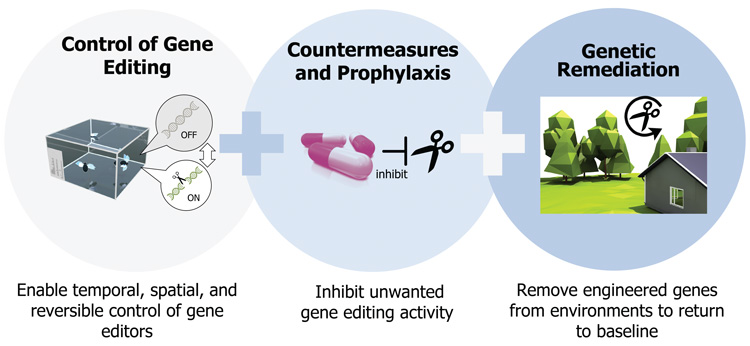Defense department pours $65 million into making CRISPR safer

With one eye on potential bioterrorism threats, the Defense Advanced Research Projects Agency today announced $65 million in funding to seven projects around the country – including one led by UC Berkeley – to improve the safety and accuracy of gene editing.
UC Berkeley will work with UC San Francisco and Sandia National Laboratories in Livermore, California, to develop better ways to insert gene-editing molecules – including CRISPR-Cas9 – into living cells; explore applications of CRISPR proteins other than the popular Cas9, such as RNA-snipping Cas13a; discover more anti-CRISPR proteins that can be used to keep gene editing under tight control; and employ these new and improved tools in the fight against major viral diseases, such as Ebola and Zika.
The research team, led by UC Berkeley’s Jennifer Doudna, who co-invented CRISPR-Cas9 gene editing, will also investigate whether these tools might someday be capable of disabling bioterrorism threats, such as novel infectious agents or weapons employing CRISPR itself.
Phase 1 funding to UC Berkeley and UCSF will amount to about $1.65 million over two years, with a potential additional two years and $1.64 million of funding. As a partner in this effort, Sandia will receive funding directly from DARPA, which is the arm of the U.S. Department of Defense that funds research in emerging technologies.
“The field of gene editing has been advancing at an astounding pace, opening the door to previously impossible genetic solutions but without much emphasis on how to mitigate potential downsides,” said Renee Wegrzyn, who manages DARPA’s Safe Genes program. “DARPA launched Safe Genes to begin to refine those capabilities by emphasizing safety first for the full range of potential applications, enabling responsible science to proceed by providing tools to prevent and mitigate misuse.”
“If successful, we will create a revolutionary platform for using and controlling gene editing for both clinical and biotechnology applications, with wide-ranging benefits for treating infectious diseases and cancer,” said Doudna, a professor of molecular and cell biology and of chemistry and a Howard Hughes Medical Institute investigator at UC Berkeley. “From a biosecurity perspective, we hope that our technologies displace less safe technologies, and by demonstrating that gene-editing activity can be prophylactically or therapeutically shut down, discouraging its potential intentional misuse.”
UC Berkeley is also part of another DARPA project funded by the Safe Genes program. Assistant Professor John Marshall has teamed up with a UC Riverside team led by Omar Akbari to develop robust and reversible gene-drive systems for control of Aedes aegypti mosquito populations.
Previous research from this team used CRISPR-Cas9 gene-editing technology to demonstrate the potential to suppress wild insects, while at the same time avoiding the resistance to these efforts that evolution would typically favor. The researchers believe this technology could be used in mosquitoes to help fight dengue, Zika, malaria and other mosquito-borne diseases in the next decade, pending public and regulatory approval. The DARPA award will fund continued work on gene-drive technology with an emphasis on biosafety and reversibility. It will also fund preliminary testing in contained, simulated natural environments and in high-throughput, rapidly reproducing populations of yeast as a model system.
Safer CRISPR
Since 2012, when Doudna and her colleague, Emmanuelle Charpentier, turned the CRISPR-Cas9 bacterial immune system into a powerful gene-editing tool, basic researchers have tweaked the Cas9 enzyme to do a variety of new tasks beyond cutting DNA, and employed it to edit genes in many different organisms, including humans. Scientists have also uncovered numerous variants of the Cas9 protein that have potential use in research or medical therapy, plus proteins called anti-CRISPRs that throw a wrench into the Cas machinery and stop gene editing.
The UC Berkeley-led collaboration will explore the potential of all of these.
“Our focus is not only to make new Cas proteins that are more accurate, but also ones that don’t necessarily cut the genome,” said Kyle Watters, a postdoctoral researcher in Doudna’s lab who is overseeing some of the work. “These engineered Cas proteins might instead prevent certain genes from being expressed, for example, so that even though they change fundamental processes in your body, they are not ultimately changing the blueprint of your DNA.”
This could involve targeting messenger RNA, the working copy of the gene used to build proteins, or recruiting enzymes to modify the epigenome – chemical signals like methyl groups that signal the cell whether to transcribe genes or leave them alone.
The researchers hope to generate new and better tools from these specialized Cas enzymes, develop anti-CRISPR proteins as a kill switch to halt gene editing – a sort of fail-safe mechanism – and explore new ways of delivering fully functional CRISPR-Cas complexes into live cells.
Among the researchers involved in the collaboration are many leaders in these fields, such as Joseph Bondy-Denomy of UCSF, who was part of the team that discovered anti-CRISPRs; Joseph Schoeniger of Sandia, who has studied novel nanoparticles that can be used to ferry CRISPR molecules into cells; Luke Gilbert and Jonathan Weissman of UCSF, who have worked on animal models for testing CRISPR therapies, such as for cancer; and Doudna herself, who has discovered many of the structures and mechanisms of action of Cas enzymes and is using them as a guide to re-engineer them for lab and clinical use.
The other projects are being led by scientists from the Broad Institute and Brigham and Women’s Hospital, Harvard University, Massachusetts General Hospital, the Massachusetts Institute of Technology and North Carolina State University.
